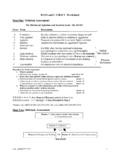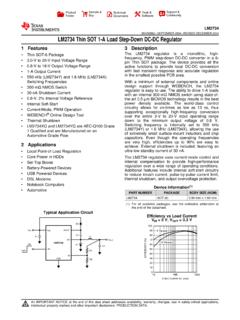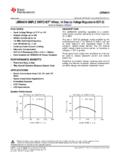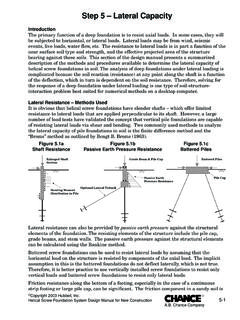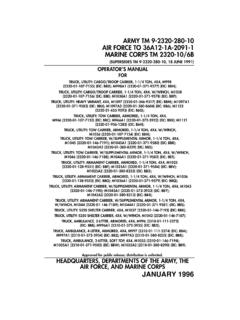Transcription of Step By Step Process For Archiving - …
1 SAP R/3 Document : BASIS ( Archiving )Created By : Subba Rao, Laxmichand & Rajasekhar1 step By step Process For ArchivingThis document is describes the steps for doing we are taking an example of Archiving the Material Master data to explain the Process we will first create a Material and then flag it for deletion and the do the Archiving for Creating A MaterialExecute the Transaction code us create a material with the name MMTESTARCH that we will flag for deletion and laterarchiving it to delete from the R/3 Document : BASIS ( Archiving )Created By : Subba Rao, Laxmichand & Rajasekhar2 Click on the Select Views button to enter the data specific to the our example we will select only BASIC DATA from the views on the Enter iconIn the Create Material General : Basic Data screen, enter the information about the fields with ? are required R/3 Document : BASIS ( Archiving )Created By : Subba Rao, Laxmichand & Rajasekhar3 After entering the data click on the Save icon to save the we have now created a the next step , we will flag the material for MMTESTARCH created message R/3 Document : BASIS ( Archiving )Created By : Subba Rao, Laxmichand & Rajasekhar4II.
2 Marking Material For DeletionTo set the Flag For Deletion for the material, choose the menu Material Flag For Deletion ImmediatelyEnter the Material name which you want to flag for deletion (in our case it is MMTESTARCH)and click on the Enter R/3 Document : BASIS ( Archiving )Created By : Subba Rao, Laxmichand & Rajasekhar5 You will get the following this screen check the Material Checkbox and click on Save iconThe material will be flagged for deletion and you will return back to initial the message bar you will get the Flag For deletion R/3 Document : BASIS ( Archiving )Created By : Subba Rao, Laxmichand & Rajasekhar6 III. Archiving ProcessNow we will see how to Archiving the Material that we have flagged for entire Archiving Process consists of the following steps / processes :1. First we need to specify the logical file path and logical filename for the material using theTransaction Code We need to specify the logical file name, Client Specific Details for the using the TransactionCode Next we start the actual Archiving Process using the transaction code we will set up the logical file path and logical file the Transaction Code R/3 Document : BASIS ( Archiving )Created By : Subba Rao, Laxmichand & Rajasekhar7 This activity is for client-independent maitainence of logical filenames and paths and includes thefollowing :1a.
3 Logical file path definations : - Freely definable descriptive name for a path in which data isto contains its own standard logical paths necessary for standard operations, but we can alsocreate our on the New Entries button on the application toolbarSpecify the Logical file path and its description in the Name columnClick on Save icon to save the R/3 Document : BASIS ( Archiving )Created By : Subba Rao, Laxmichand & Rajasekhar81b. Assigments of physical paths to the logical pathSelect the logical path that you on the Assignment of physical paths to logical path optionSAP R/3 Document : BASIS ( Archiving )Created By : Subba Rao, Laxmichand & Rajasekhar9 Conversion of logical path to a physical path is dependent on operating systems. For this reason,generally several physical paths can be assigned to one logical path. It consists of followingvalues : Logical path : Name of the logical file path to which the physical path is assigned Name : Short description of the logical file path Syntax group : Name of the syntax group for which the physical path applies Physical path : Platform-specific path.
4 It may contain reserved words as placeholders thatare replaced by system values at runtime. It must include the reservedword <FILENAME> as placeholder for the since we have already defined the logical path and the Name, we will now define the Syntaxgroup and the Physical R/3 Document : BASIS ( Archiving )Created By : Subba Rao, Laxmichand & Rajasekhar10 Click on the New Entries button on the application toolbarSpecify the Syntax Group (eg. WINDOWS NT) and Physical PathAfter you specify the Syntax Group and the Physical Path, click on the Enter is a System Variablefor the Physical file namewhich we will define inthe next convention R/3 Document : BASIS ( Archiving )Created By : Subba Rao, Laxmichand & Rajasekhar11 Click on the Save icon. You will be prompted to enter a Change Request Number. Enter yourchange request number and click on the Enter iconNow the Data will be on Back icon to come back to the inital screen.
5 Now you can see that the Syntax Group isdisplayed in the Syntax Group columnSAP R/3 Document : BASIS ( Archiving )Created By : Subba Rao, Laxmichand & Rajasekhar12 Now select this Syntax Group and click on Logical file name defination, client this step we maintain the logical file name for all definition of a logical filename comprises the following values: Logical filename : Descriptive name for a file to be stored. Name : Short description explaining the use of the file. Physical filename : Physical filename assigned to the logical filename. It may containreserved words as placeholders that are replaced by system values atruntime. The physical filename can also include a path. In this case,the logical filename only applies to one platform, and a logical pathmust not be specified. Data format : Three-character key (for example, ASC). The data format is required whenfiles are downloaded to the presentation server.
6 It can also be used as afilename extension. Application area : Two-character key (for example, SD) that identifies where the file isutilized but is of no functional significance. Logical path : Name of the logical path where the file is to be stored. The logical pathserves to determine the physical path for the file to be stored, depending onthe syntax group in question. If no logical path is specified, theSAP R/3 Document : BASIS ( Archiving )Created By : Subba Rao, Laxmichand & Rajasekhar13 FILE_GET_NAME function module at runtime returns only the physicalfilename (see above), replacing any placeholders it may on the New Entries button on the application toolbarAfter entering the all the information, click on the Save on the Back the logical file name that you have now created should be displayed in the Enter the Logical File Enter the description3. Enter the Physical file name. You can use some system variables to make upyour filename.
7 Press F1 on the field to get a list of systems variable. Forexample we have used <PARAM_1> for Application Id ( ), <MONTH>to include the month Data Format ( ASC)5. Application ( MM in our case)6. Logical Path, which we had created earlierSAP R/3 Document : BASIS ( Archiving )Created By : Subba Rao, Laxmichand & Rajasekhar14II PHASENow you should use the Transaction Code SF01 to maintain the logical filenames for the currentclient. So, make sure that you have logged onto the right the Transaction Code SF01 SAP R/3 Document : BASIS ( Archiving )Created By : Subba Rao, Laxmichand & Rajasekhar15 Click on the New Entries button on the application toolbarJust select the Logical File that you created from the dropdown box and the rest of theinformation will automatically on the Save iconSpecify the Change Request on Back icon to come to the initial screenSAP R/3 Document : BASIS ( Archiving )Created By : Subba Rao, Laxmichand & Rajasekhar16 III.
8 PHASENow you start the actual Archiving Process using the Transaction Code application area will have some specific Archiving objects associated with them. Forexample the Archiving object for Material Master is MM_MATNRSAP R/3 Document : BASIS ( Archiving )Created By : Subba Rao, Laxmichand & Rajasekhar17 Enter the concerned Archiving object name in the Object Name fieldClick on the Customizing button on the application the Log. File name that you created from the dropdown R/3 Document : BASIS ( Archiving )Created By : Subba Rao, Laxmichand & Rajasekhar181. Check this box for Automatic Deletion of the material from the database, the deletionprogram will be started Check this box to link any Third Party Tool that you maybe using for the specifying the Logical file name, click on the Save the Change Request NumberClick on the Back icon to return to the initial on Preparation you need to create a on the Maintain buttonSAP R/3 Document : BASIS ( Archiving )Created By : Subba Rao, Laxmichand & Rajasekhar19A subscreen will a variant name and click on the Create specify the Material Number or Range of Material Numbers to be our case it is MMTESTARCHSAP R/3 Document : BASIS ( Archiving )Created By : Subba Rao, Laxmichand & Rajasekhar20 Click on the Continue button on the application toolbarEnter the description for the on the Save on the Back icon to come to the Archive Management : Preparation screenSAP R/3 Document.
9 BASIS ( Archiving )Created By : Subba Rao, Laxmichand & Rajasekhar21 Next click on the Start Date buttonSpecify the period and start time for the execution of the Archiving Process . In our case, we haveselected on Save and Check iconsClick on Spool param. ButtonSAP R/3 Document : BASIS ( Archiving )Created By : Subba Rao, Laxmichand & Rajasekhar22 Maintain the Spool parameters and click on the Save buttonYou will once again return to the Arhive Management : Preparation the Traffic Light buttons next to the Start Date and Spool param. Buttons should haveturned greenSAP R/3 Document : BASIS ( Archiving )Created By : Subba Rao, Laxmichand & Rajasekhar23 Now click on the Execute button on the application toolbarNow the traffic buttons should turn YellowSAP R/3 Document : BASIS ( Archiving )Created By : Subba Rao, Laxmichand & Rajasekhar24 Click on the Job Overview button on the toolbarTwo jobs will created with the format ARV_< Archiving OBJECT>_PRE<DATE> <TIME>and ARV_< Archiving OBJECT>_SUB<DATE> <TIME>These jobs should have the Release statusClick on the Back iconClick on the Back icon to come back to the Archiving Initial R/3 Document : BASIS ( Archiving )Created By : Subba Rao, Laxmichand & Rajasekhar25 Click on the Archive buttonClick on the Maintain button and create a variant as done earlierAfter you specify the variant and click on the Create button, you will get the following screenUncheck the Test Mode buttonSAP R/3 Document.
10 BASIS ( Archiving )Created By : Subba Rao, Laxmichand & Rajasekhar26 Click on the Continue button on the toolbarSpecify the Variant on the Save icon .Click on the Back the Start Date and Spool param as R/3 Document : BASIS ( Archiving )Created By : Subba Rao, Laxmichand & Rajasekhar27 Click on Execute button on the should get New Archivingjob created .SAP R/3 Document : BASIS ( Archiving )Created By : Subba Rao, Laxmichand & Rajasekhar28 Click on the Job Overview buttonTwo jobs will created with the format ARV_< Archiving OBJECT>_WRI<DATE> <TIME>and ARV_< Archiving OBJECT>_SUB<DATE> <TIME>These jobs should have the Release statusClick on the Back icon twice to get to the Archive Management : Initial Screen screenSAP R/3 Document : BASIS ( Archiving )Created By : Subba Rao, Laxmichand & Rajasekhar29 Now before you proceed further, you can check whether the archive file was created or not. Youcan also check the tables, which will be affected by this check whether the archive file was created or not, click on Management buttonThe yellow colored entry is our is our traffic light yellow because thematerial has been archived into anarchive file but not yet deleted fromthe R/3 Document : BASIS ( Archiving )Created By : Subba Rao, Laxmichand & Rajasekhar30 Double click on the entry to get further details about the archive fileIf the Archiving Process was completed successfully, you will get the filename and traffic light ingreen on the Enter will now return back to the Archive Management: Archiving session overview on the Back icon to return to the Archive Management: Initial Screen is the file path and name that hasbeen R/3 Document : BASIS ( Archiving )Created By.







